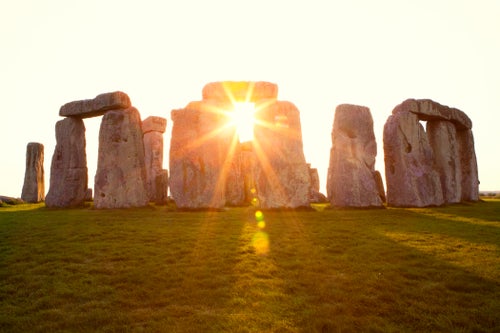

This week will mark a special day in many calendars around the world – the winter solstice.
While it may just seem like the shortest day of the year, the occasion is rich in tradition and cultural meaning.
Here’s why it’s such a big deal.
What is the winter solstice?
The winter solstice marks the shortest day of the year in the northern hemisphere – December 21 or 22, depending on where you are in the world.
It marks a point in the yearly calendar when the sun is lowest in the northern hemisphere sky and at the farthest southern point over Earth.
After this date it will start to return to the north.
It also means that from now onwards, the amount of daylight each day will gradually increase up until late June, when the summer solstice occurs.
So sunrises will start getting earlier and sunsets will start getting later. Curiously, in astronomical terms, the winter solstice is the start of winter too, and so becomes a time for renewal.
Solstice comes from the Latin words for “sun stands still” a reference to when the star seems to be stationary in the sky for three days of the year before moving back in the opposite direction in both winter and summer.
The phenomenon happens because of the tilt of the Earth’s axis, which gives us the four seasons.
More daylight hours is of course a cause for celebration in itself – but the day has a special meaning across many different cultures.
What does it have to do with Stonehenge?
Stonehenge is a landmark near Salisbury and arguably one of the most famous prehistoric monuments in Europe.
The structure is made up of stones standing up to 13ft in height arranged in rings, and was built more than 5,000 years ago – although its exact purpose remains shrouded in mystery to this day.
What we do know though is that it is connected to the sun.
As explained by Stonehenge’s Twitter account, the stone monument actually aligns perfectly to the sun’s positioning on both the winter and summer solstice, allowing the light to shine between the rocks on these two days of the year.
So on the shortest day of the year, the sun sets through the central pillar – and the biggest stones of all surround this one, suggesting this was the most important day in our ancestors’ calendar.
Excavations have revealed that people held huge feasts near this time of year in the nearby settlement, too.
Is it just Stonehenge?
No – other monuments around the world honour the occasion as well, most of which date back to a time when humanity had to rely on their knowledge of the sun and the stars to live.
Newgrange, in Ireland, is older than both Stonehenge and the Egyptian pyramids. The tomb’s passage and chamber and lit up by the winter solstice sun every year.
A monument in what is now known as the US state of Illinois also appears to honour the solstice – Woodhenge was built around 1,000 years ago.
Festivals around the world such as Dongzhi in China, Iran’s Yalda, the Zuni’s Shalako in New Mexico and Pure’s Inti Raymi, all honour the return of the sunlight during their own winter solstices too.
As indigenous writer from University of Illinois and Urbana-Champaign scholar, Rosalyn LaPier, explained: ”Although some winter solstice traditions have changed over time, they are still a reminder of indigenous peoples’ understanding of the intricate workings of the solar system.”
So, why is the solstice celebrated?
Themes from around the world suggest the solstice is linked to rebirth, renewal and giving thanks, as well as a sign that light conquers darkness.
However, it has a more complicated meaning too.
As it is the first official day of winter, it can be described as the start of “wintering”, a time when we need to restore.
As Katherine May, author of Wintering: The Power of Rest and Retreat in Difficult Times, said: “Wintering… is the courage to stare down the worst parts of our experience and to commit to healing them the best we can.”
And we could all use some healing after the year that’s been.
Winter calls for us to take greater care of ourselves and each other at this time of year, from our health and homes to our headspace and matters of the heart. Whether you’re seeking motivation or hibernation, HuffPost UK’s Winter Well series is here to help you through the short days and the longer months.